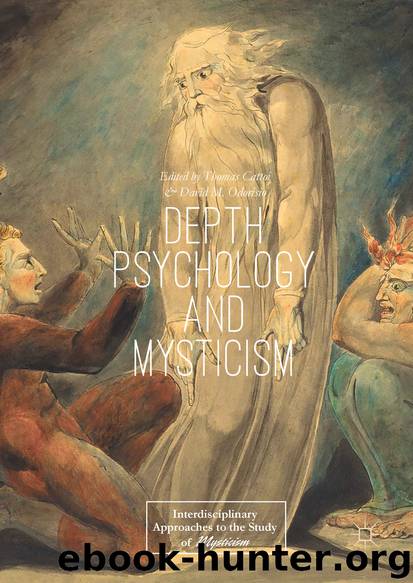Depth Psychology and Mysticism by Thomas Cattoi & David M. Odorisio

Author:Thomas Cattoi & David M. Odorisio
Language: eng
Format: epub
Publisher: Springer International Publishing, Cham
In the classic reductive approach, there is no light, only atmospherics and projection, often understood (and easily dismissed) as pathology. In contrast, another strand within the psychology of mysticism has promoted what can be referred to as an adaptive approach. This is illustrated in Carol Zaleski’s (1987) refusal to side with either the religious or reductive psycho-physiological interpretation of near-death experiences in favor of a Jamesian adaptive, pragmatic perspective on the value of the religious imagination. For Zaleski, it is not so much the different perspectives on the origin of NDE that matters (one emphasizing materialistic reductionism, the other allowing for consciousness beyond materialism) so much as their effect on the life narrative of individuals (usually positive). This is again evident in Kenneth Wapnick’s (1980) analysis of St. Teresa. Utilizing the more “adaptive” theories of schizophrenia extant in the 1960s and the case history of a schizophrenic episode (that of Lara Jeffries), Wapnick frames Teresa as an example of a more “successful” and adaptive version of what can be called “churched” schizophrenia. Again, engaging Zen, Herbert Fingarette (1965), utilizing case histories run through ego psychology, concludes that the Zen concept of the “no-self” is equivalent to “losing” the “transference self.” Buddhism, in effect, is rewritten as a kind of “eastern psychoanalysis” complete with an “eastern” nomenclature. While this is undoubtedly a more favorable view of mysticism, one may ask: what has happened to the religious insistence (the “farther” side) of the More?
Scholars of religion might begin to answer this question by pointing out that in many cases the psychological reconstruction and understanding of a specific mystical text or figure are not always accurate. That is to say, if one is to analyze a text as an instance of a “case history,” it behooves one to at least get the case right. Thus, for example, Franz Alexander’s (1931) pathologizing of Buddhism clearly drew upon suspect third-party sources and bad translations in his “armchair” analysis of nirvana (Parsons 2009, 179–210). Again, Wapnick’s (1980) summary of Teresa’s mystical process is more than questionable and obscures the nature and intent of both her “experiences” (not only does he focuses only on the episodic “union” of the fifth mansion, which is not as important for Teresa as the permanent “union” of the spiritual marriage or the “union” of wills, but he also neglects the entirety of visions, raptures, and locutions of Mansion 6) and her “process” (indeed for Teresa the goal is in fact “union” with God’s will, namely an active saintly altruism, mystical “experiences” being but facilitators of that aim). For the scholar of religion, one can only conclude that Wapnick has misread the “case” of Teresa.
The question of “what happened to the text” can take a more convoluted, if not twisted, turn. Take, for example, the contemporary ambivalence concerning the introduction of “mindfulness” as part and parcel of a western culture seeking tension release. Adepts in the “traditions” may feel that meditative practices, once uprooted from their metaphysical and ethical matrix, can only lead to a misappropriation of their true aim and import.
Download
This site does not store any files on its server. We only index and link to content provided by other sites. Please contact the content providers to delete copyright contents if any and email us, we'll remove relevant links or contents immediately.
Rewire Your Anxious Brain by Catherine M. Pittman(18555)
Talking to Strangers by Malcolm Gladwell(13235)
The Art of Thinking Clearly by Rolf Dobelli(10234)
Mindhunter: Inside the FBI's Elite Serial Crime Unit by John E. Douglas & Mark Olshaker(9214)
Becoming Supernatural by Dr. Joe Dispenza(8127)
Change Your Questions, Change Your Life by Marilee Adams(7641)
Nudge - Improving Decisions about Health, Wealth, and Happiness by Thaler Sunstein(7622)
The Road Less Traveled by M. Scott Peck(7525)
The Lost Art of Listening by Michael P. Nichols(7412)
Enlightenment Now: The Case for Reason, Science, Humanism, and Progress by Steven Pinker(7243)
Mastermind: How to Think Like Sherlock Holmes by Maria Konnikova(7234)
Win Bigly by Scott Adams(7097)
The Way of Zen by Alan W. Watts(6513)
Daring Greatly by Brene Brown(6451)
Big Magic: Creative Living Beyond Fear by Elizabeth Gilbert(5618)
Grit by Angela Duckworth(5525)
Ego Is the Enemy by Ryan Holiday(5298)
Men In Love by Nancy Friday(5162)
Altered Sensations by David Pantalony(5048)
